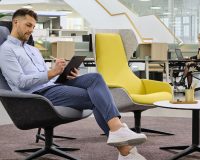The workplace has gone soft and I mean that in a good way. Over the past twenty or more years we have experienced the very welcome development of a much softer aesthetic generally when it comes to the design of offices. This process has accelerated dramatically in recent years as more and more firms have turned to models of flexible and agile working as a source of competitive advantage and because they have seen a growing number of examples of how to pull it all off. Sometimes, wrongly characterised as the domestication of design, this is linked to the way that management thinking and consequently workplace design has focused on softer business issues such as corporate culture, the environment and knowledge management.
To a large extent this has come about as a matter of necessity. At its heart are several interrelated issues. The most important is this; if your main asset is knowledge, how do you attract the heads that contain that knowledge to your organisation? Then, once they are safely in your employ, how do you make them stay there or at the very least empty some of the contents into computers and other people’s heads before they go? And finally, how do you address their wellbeing in ways that meet their own needs and those of the organisation.
It is this fundamental conundrum that has led to the dominance of ‘soft’ issues in management thinking. From the perspective of workplace design, it has driven the growth of flexible work practices and agile working as organisations have tried to give people a better work-life balance. It has driven the softening of the workplace itself, the growth of break-out space and the focus on the team.
It’s pushed on the ideas of employer branding and user experiences at work, two ideas that started as primarily HR led but which are now seen as valuable at a corporate level and so consequently as influencers of interior design. It’s driven a new emphasis on knowledge management. In the old days, knowledge was filed in tin boxes and searches of bags meant firms could keep key information secure and in-house. If people left, a lot of what they knew and worked with wasn’t as likely to disappear out of the door with them.
A changing psychological contract
The resulting change in the psychological contract between employer and employee is both a consequence and a cause of these changes. It has also coincided with two other external factors that in the very near future will have a profound effect on the way businesses function and how they design and manage their workplaces.
Firstly, the quietly thriving economy of recent years not only offered us nearly full employment and skills shortages in important areas like the legal, tech and creative sectors but as a consequence also handed the whip hand to employees who were able to demand new and better job conditions in exchange for their loyalty. Flexible and agile working are growing expectations for people at work.
Secondly, a new mix of generations of people is involved in running things. The baby-boomers have already been joined by idealistic, questioning Generation-Xers as the key decision makers in organisations. Now the people of Generation Y and Z are set to transform the workplace in their own ways. These are the first generations of people that have no conception of a world that does not allow them to have constant and instant access to information, entertainment and other people. They are only dimly aware of a quaint lost world of coin-operated phones, faxes, letters and four channel television even if the dim and fading echoes of that world still surround us.
To a large extent their relationship with the world is defined by their relationship with technology even more than their older colleagues. They take access to technology for granted. They accept its pervasive influence, its ubiquity, its ephemeral nature and demand the latest stuff, even if that means coldly discarding technology that was seen as state of the art just months before.
The economy is now founded on knowledge rather than just information, and as a result, the office is assuming both the functions and aesthetic of more relaxed. collaborative public spaces such as hotels and cafes and even profoundly private spaces such as our homes.








